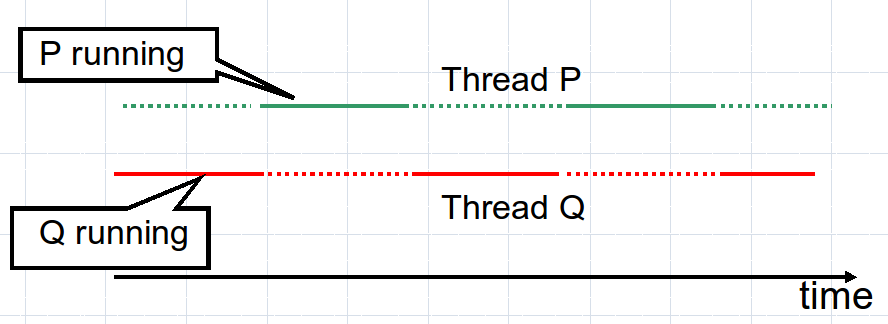Introduction
Teaching team
Why concurrent programming?
In general
In this course
Gentle start
- Java
Teaching team
- Check the information tab
Why concurrency?

Where is John von Neumann?
Using the processor efficiently in the presence of I/O
Operating systems
Distributed systems
Real-time systems

Modeling inherently concurrent systems
- Software controllers which handle responses from several physical sources
The world is concurrent!
Multi-core machines
Cell phones
Laptops
Performing computationally expensive tasks using several processors


Concurrency vs. Parallelism
Parallell programmering ≠ parallel programming
Parallel
- Physically at the same time
Concurrent
- Logically at the same time, but might be implemented without any real parallelism
The book covers parallel programming too – but we will briefly focus on it in the course
Course (general) goals
Introduction to the problems common to many computing disciplines:
- Operating systems
- Distributed systems
- Real-time systems
Appreciation of the problems of concurrent programming
- Classic synchronisation problems
Understanding of a range of programming language constructs for concurrent programming
Ability to apply these in practice to synchronisation problems in concurrent programming
Practical knowledge of the programming techniques of modern concurrent programming languages
Practical course information
About the course activities
Two lectures per week
Six supervision/exercise hours
Optional weekly exercise classes. Attend at most one, with your lab partner
Assignments
- Four programming assignments – “labs” (two in Java and two in Erlang)
-
- 4 hours
- Closed book
-
Intended to answer most basic questions
Email tda382@googlegroups.com
Gentle start
Introduction to concurrent programming
Basic understanding
- Concurrent programming concepts
- Threads
- State, Execution, Scheduling
Synchronisation problems
Introduction to programming languages
- Java
A summer job
- Cremona decide to employ experts to increase sales. Their solution:
Buy @ Cremona!
The message must be flashed every three seconds (For the example, you need the JFLash class)
import javax.swing.*; public class Main6 { private JFlash window; private Thread buyThread; private final int buy_pause = 3000; public Main6() { window = new JFlash("Cremona"); SwingUtilities.invokeLater(window); buyThread = new Thread() { public void run() { while (true) { window.flash("Buy @ Cremona!"); try { Thread.sleep(buy_pause); } catch (InterruptedException e) {} } } }; buyThread.start(); } public static void main(String[] args) { new Main6(); } }
The program does not increase sales as predicted. A psychologist is called in to help!
- An additional message is needed: the sign must flash Free beer! every 5 seconds
Free beer!
- The program is now more complex

final int buy_pause = 3000;
final int beer_pause = 5000;
int next_buy = buy_pause;
int next_beer = beer_pause;
...
buyThread =
new Thread() {
public void run() {
while (true) {
if (next_buy < next_beer) {
try { Thread.sleep(next_buy); }
catch (InterruptedException e) {} ;
window.flash("Buy @ Cremona");
next_beer = next_beer - next_buy;
next_buy = buy_pause;
}
else if (next_buy > next_beer) {
try { Thread.sleep(next_beer); }
catch (InterruptedException e) {} ;
window.flash("Free beer!");
next_buy = next_buy - next_beer ;
next_beer = beer_pause ;
}
else {
try { Thread.sleep(next_buy); }
catch (InterruptedException e) {} ;
window.flash("Buy @ Cremona! - Free beer!");
next_buy = buy_pause ;
next_beer = beer_pause ;
}
}
}
}
A more natural solution is to run the two simple algorithms concurrently:
final int buy_pause = 3000; final int beer_pause = 5000; buyThread = new Thread() { public void run() { while (true) { window.flash("Buy @ Cremona!"); try { Thread.sleep(buy_pause); } catch (InterruptedException e) {} } } }; beerThread = new Thread() { public void run() { while (true) { window.flash("Free beer!"); try { Thread.sleep(beer_pause); } catch (InterruptedException e) {} } } };
Java threads
Java threading framework
- The
Threadclass provides the API and generic behaviours A concrete thread must provide arun()method which is the code that the thread will execute when started
- The
Providing thread
run()method- Inheritance
class Buy extends Thread { //some init public void run() { while (true) { window.flash("Buy @ Cremona!"); //add napping here } } }- Implement interface
Runnable
class Buy implements Runnable { //some init public void run() { while (true) { window.flash("Buy @ Cremona!"); //add napping here } } }- Using anonymous inner classes
buyThread = new Thread() { public void run() { while (true) { window.flash("Buy @ Cremona!"); //add napping here } } };
Running Java threads
Invoking the
run()method in a new threadInheritance
buyThread = new Buy(…); buyThread.start();
Interface
buyThread = new Thread(new Buy(…)); buyThread.start();
Anonymous classes
buyThread = new Thread(public void run() {...}); buyThread.start();
Napping in Java
A sleeping thread can be interrupted, hence the need for the catch/try clause
try { Thread.sleep(milliseconds); } catch (InterruptedException e) { //Panic: do something here! }More on this later
Concurrent programming languages
Using such languages we are going to
Explore concurrency problems and solutions
Understand how modern programming languages support concurrent programming
Main course programming languages
Java
Erlang
Threads scheduling
- On a uniprocessor system threads appear to run at the same time but in fact their execution must be interleaved

The job of switching between threads is performed by the scheduler
Part of the run-time system, or
Performed using the operating system’s processes and scheduler
Many different methods of scheduling exist
Cooperative scheduling
- a thread runs until it is willing to release the processor (e.g. sleep or termination)
Preemptive scheduling
a thread is interrupted in order to let other threads continue (e.g. time-slicing)
Erlang have a preemptive scheduler
Most modern JVM’s are also preemptive
Types of precess behaviour
- A thread

Independent
Relatively rare; Rather uninteresting



Competing
Typical in OS and networks, due to shared resources



Deadlock





Starvation




Cooperating
Processes combine to solve a common task
Synchronization











Atomicity
An atomic action is something that is guaranteed to execute without interruption
Since the execution of different threads is interleaved, what are the atomic actions?
Single instructions?
Basic code blocks?
Answer: might not specified by the language design. We have to assume the worst! Context switch can occur anywhere, also in the middle of a statement.
What if flash is not atomic for the Cremona display?
while (true) { window.flash("Buy @ Cremona!"); try { Thread.sleep(buy_pause); } catch (InterruptedException e) {} }while (true) { window.flash("Free beer!"); try { Thread.sleep(beer_pause); } catch (InterruptedException e) {} }
Example: The Liseberg counter
How many people have entered Liseberg at any given time?
Each entrance has turnstiles which record when a person enters or leaves

public class Liseberg { private int counter = 0 ; private Thread east ; private Thread west ; public void done() { System.out.println("Counter: "+counter); } public void enter() { counter++; } public void people (String x) { for(int j = 0; j<100; j++) { try { Thread.sleep(500 + (int)(Math.random()*1000)) ;} catch (InterruptedException e) {} ; System.out.println("Process "+x+" enters "+j); enter(); } ; done() ; } public Liseberg () { east = new Thread() { public void run() { people("East") ; } } ; west = new Thread() { public void run() { people("West") ; } } ; east.start() ; west.start() ; } public static void main(String[] args) { new Liseberg(); } }To appreciate better the lack of atomicity, change the lines 15-18 by the following ones
for(int j = 0; j<1000000; j++) { //try { Thread.sleep(500 + (int)(Math.random()*1000)) ;} //catch (InterruptedException e) {} ; //System.out.println("Process "+x+" enters "+j);
What is the answer?
We expect the answer 200
It depends on the
counter++operation being atomicLet us disassemble
Liseberg.class(we use the decompiler Jad for that)public void enter() { counter++; }0:aload_0 1:dup 2:getfield #6 Field int counter 5:iconst_1 6:iadd 7:putfield #6 Field int counter 10:return
From, above line
2gets the content of the fieldcounterin the stack and line 7 storescounter+1back into that field
Terminology: States and traces
A program executes a sequence of atomic actions
A state is the value of the program variables at any point in time
A trace (or history) is a sequence of states that can be produced by the sequence of atomic actions of a program
A bad trace
- Suppose the first atomic actions of the Turnstile processes are interleaved as follows:
| Turnstile East | Turnstile West |
|---|
counter = 0
0:aload_0
|
|
0:aload_0
|
counter = 0
7:putfield #counter
10:return
|
counter = 1
7:putfield #counter
10:return
|
counter = 1
- We lost one person on the way!
Program properties
A
propertyof a program is a logical statement that is true for every possible traceTwo kinds of property are usual for stating correctness properties of concurrent programs
Safety property : a trace never enters a bad state
Liveness property: every trace eventually reaches a good state
Examples of safety properties
The program never produces a wrong answer
An invariant like
(x + y < 2)
Examples of liveness properties
The thread terminates
The thread eventually calls a certain procedure
Synchronisation
Synchronisation is the restriction of the traces of a concurrent program in order to guarantee certain safety properties
We will see at least two kinds of synchronisation:
Mutual exclusion
- Conditional synchronisation
Critical sections
The bad traces in the Liseberg problem are caused by the code that implements
counter++To fix the problem it must be executed atomically
- Without any interleaving or parallel activity
Critical section
- A part of a program that must be executed atomically
Mutual exclusion
It is the property that only one thread can execute in a given piece of code at any given time
How can we achieve it?
Theory: possible with just shared variables
- Very inefficient at the programming language level, but sometimes necessary in very low-level of abstraction (Hardware)
Practice: programming language features (semaphores, monitors, etc.)
Summary
Today’s lecture
- Introduction to concurrency
- Threads in Java
- The shared update problem (Liseberg): mutex
Next time
- Solving the shared update problem Introduction to a first programming
- language construct for synchronisation (semaphores)